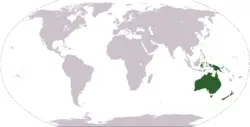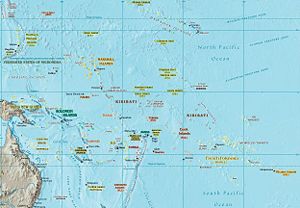Difference between revisions of "Oceania" - New World Encyclopedia
John Willis (talk | contribs) (removed supercategory) |
John Willis (talk | contribs) (returned G&D tag) |
||
| Line 1: | Line 1: | ||
| − | |||
[[Category:Global regions]] | [[Category:Global regions]] | ||
| + | [[Category:Geography and demographics]] | ||
[[Image:LocationOceania.png|thumb|250px|World map showing Oceania (geographically)]] | [[Image:LocationOceania.png|thumb|250px|World map showing Oceania (geographically)]] | ||
Revision as of 09:02, 22 December 2005
Oceania is a geographical (often geopolitical) region consisting of numerous countries and territories – mostly islands – in the Pacific Ocean. The exact scope of Oceania is controversial, with varying interpretations including East Timor, Australia, New Zealand, or none of these.
Overview
The primary use of the term Oceania is to describe a continental region (like Europe or Africa) that lies between Asia and the Americas, with Australia as the major land mass. The name Oceania is used, rather than Australia, because unlike the other continental groupings, it is the ocean rather than the continent that links the nations together. Oceania is the smallest continental grouping in land area and the second smallest, after Antarctica, in population.
Countries and territories of Oceania
Oceania has been traditionally divided into Micronesia, Melanesia and Polynesia (originally by the French explorer Dumont d'Urville in 1831). This subdivision is no longer recognised as correct by most geographers and scientists — who prefer to divide Oceania into Near Oceania and Remote Oceania — but it is still the most popular one.
Most of Oceania consists of small island nations. Australia is the only continental country, and Papua New Guinea and East Timor are the only countries with land borders, both with Indonesia.
The nations of Oceania have varying degrees of independence from their colonial powers and have negotiated a wide range of constitutional arrangements to suit their circumstances. The following list contains the countries and territories that are classified as part of Oceania by UNESCO; other countries are sometimes considered part of Oceania (see Other Interpretations below).
- Australia - Commonwealth Realm1
- Norfolk Island - external territory of Australia
- East Timor - republic
- Fiji - republic
- New Caledonia - sui generis collectivity of France2
- Papua New Guinea - Commonwealth Realm1
- Solomon Islands - Commonwealth Realm1
- Vanuatu - republic
- Guam - organised, unincorporated territory of the United States
- Kiribati - republic
- Marshall Islands - republic in free association with the United States
- Micronesia, Federated States of - republic in free association with the United States
- Nauru - republic
- Northern Mariana Islands - organised, unincorporated commonwealth in political union with the United States
- Palau - republic in free association with the United States
- Wake Island - unorganised, unincorporated territory of the United States
- American Samoa- unorganised, unincorporated territory of the United States
- Cook Islands - self-governing state in free association with New Zealand
- French Polynesia - "overseas country" of France2
- Niue - self-governing state in free association with New Zealand
- New Zealand - Commonwealth Realm1
- Pitcairn - overseas territory of the United Kingdom
- Samoa - constitutional monarchy under Malietoa Tanumafili II
- Tokelau - semi-autonomous territory of New Zealand
- Tonga - absolute monarchy under King Taufa'ahau Tupou IV
- Tuvalu - Commonwealth Realm1
- Wallis and Futuna Islands - overseas collectivity of France2
Other interpretations of Oceania
- Australia is sometimes not included in Oceania, although a term like Pacific islands would normally be used to describe Oceania without Australia
- Hawaii and the United States territories with no indigenous population in the North Pacific are sometimes included, but are normally grouped with the United States in North America. Hawaiians are a Polynesian race.
- Easter Island is a Polynesian island in the eastern Pacific Ocean, part of the territory of Chile, and is sometimes included in Oceania.
- On rare occasions the term may be stretched even further to include other Pacific island groups such as the Aleutian Islands.
Oceania in ecology
Oceania is one of eight terrestrial ecozones, which constitute the major ecological regions of the planet. The Oceania ecozone includes all of Micronesia, Fiji, and all of Polynesia except New Zealand. New Zealand, along with New Guinea and nearby islands, Australia, the Solomon Islands, Vanuatu, and New Caledonia, constitute the separate Australasia ecozone.
Population density
This is a list of countries/dependencies by population density in inhabitants/km².
Unlike the figures in the country articles, the figures in this table are based on areas including inland water bodies (lakes, reservoirs, rivers) and may therefore be lower here.
| country | pop. dens. | area | population |
|---|---|---|---|
| (/km²) | (km²) | (2002 est.) | |
| Nauru | 587 | 21 | 12,329 |
| Tuvalu | 429 | 26 | 11,146 |
| Marshall Islands | 407 | 181 | 73,630 |
| American Samoa (US) | 345 | 199 | 68,688 |
| Guam (US) | 293 | 549 | 160,796 |
| Federated States of Micronesia | 194 | 702 | 135,869 |
| Northern Mariana Islands (US) | 162 | 477 | 77,311 |
| Tokelau (N.Z.) | 143 | 10 | 1,431 |
| Tonga | 142 | 748 | 106,137 |
| Kiribati | 119 | 811 | 96,335 |
| Cook Islands (N.Z.) | 87 | 240 | 20,811 |
| East Timor | 68 | 15,007 | 1,019,252 |
| French Polynesia (Fr.) | 62 | 4,167 | 257,847 |
| Samoa | 61 | 2,944 | 178,631 |
| Wallis and Futuna (Fr.) | 57 | 274 | 15,585 |
| Norfolk Island (Aus) | 53 | 35 | 1,866 |
| Fiji | 47 | 18,270 | 856,346 |
| Cocos Islands (Aus) 1 | 45 | 14 | 632 |
| Palau | 42 | 458 | 19,409 |
| Solomon Islands | 17 | 28,450 | 494,786 |
| Vanuatu | 16 | 12,200 | 196,178 |
| New Zealand | 15 | 268,680 | 3,908,037 |
| Papua New Guinea | 11 | 462,840 | 5,172,033 |
| New Caledonia (Fr.) | 11 | 19,060 | 207,858 |
| Niue (N.Z.) | 8.2 | 260 | 2,134 |
| Christmas Island (Aus) 2 | 3.5 | 135 | 474 |
| Australia | 2.5 | 7,686,850 | 19,546,792 |
| Pitcairn Islands (UK) | 1.0 | 47 | 47 |
| Total | 3.7 | 8,523,655 | 32,642,390 |
1 Located in the Indian Ocean, not in Oceania.
2 This Christmas Island is in the Indian Ocean—not the one part of the Line Islands;
a territory of Kiribati
Sport
External links
- Jane's Oceania Home Page
- Map showing Oceania in relation with America
- Map
- Map South Pacific
- Oceania photos and information
- Open-Site Oceania - Information about the different countries of Oceania.
- Pacific Pictures
- South Pacific Organizer
Credits
New World Encyclopedia writers and editors rewrote and completed the Wikipedia article in accordance with New World Encyclopedia standards. This article abides by terms of the Creative Commons CC-by-sa 3.0 License (CC-by-sa), which may be used and disseminated with proper attribution. Credit is due under the terms of this license that can reference both the New World Encyclopedia contributors and the selfless volunteer contributors of the Wikimedia Foundation. To cite this article click here for a list of acceptable citing formats.The history of earlier contributions by wikipedians is accessible to researchers here:
The history of this article since it was imported to New World Encyclopedia:
Note: Some restrictions may apply to use of individual images which are separately licensed.

